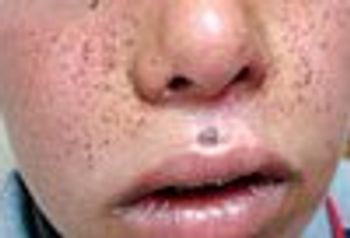
Many physicians are not monitoring children's blood pressure during ambulatory or preventive care visits as recommended by the American Academy of Pediatrics (AAP) and the National Heart, Lung, and Blood Institute (NHLBI).

Many physicians are not monitoring children's blood pressure during ambulatory or preventive care visits as recommended by the American Academy of Pediatrics (AAP) and the National Heart, Lung, and Blood Institute (NHLBI).

Tooth pain, dental disease, and poor access to dental care adversely affect how children perform in school and are associated with increased school absences and missed parental days of work.

Children who are overweight or obese, especially girls, face an increased risk for developing gallstone disease compared with their normal-weight peers, according to research by Kaiser Permanente Southern California.

You are called to the emergency department to evaluate a 2-year old boy with a fever for 5 days and a rapidly spreading rash on his face, arms, and legs for 2 days. The rash was made up of 3-mm to 6-mm diameter elongated vesicles on a red base. He is irritable and not eating well. There was another child at his day care with a similar rash, and his mother is worried that his 8-month old brother will develop the same illness.

Among 100 primary care physicians recently polled about electronic health record (EHR) systems, approximately 40% cited financial problems as their practices’ biggest hurdle, whereas another 40% listed EHR implementation itself. More >>

The National Institutes of Health (NIH) is revamping its Back to Sleep campaign for the prevention of sudden infant death syndrome to address a wider awareness of all causes of sudden unexpected infant death. The goal is to promote education among health care providers, parents, and caregivers regarding safe sleep practices for all infants. More >>

New research has linked bisphenol A (BPA), a chemical commonly found in the lining of metal cans, food packaging, polycarbonate drink bottles, and other consumer products, to obesity in children and adolescents. More >>

Adolescents who smoke marijuana on a regular basis face a decline in intelligence and brain function as adults, even if they quit using the drug later on. The findings are the first to associate a drop in neuropsychological functioning with cannabis use. More >>

Why Should I Sleep? Patient Handout


Electronic health record (EHR) systems affect the workflows of small-practice physicians mostly negatively, whereas the workflows of their staff members are generally improved, according to recent research. More >>

Only confirmed cases of group A streptococcal pharyngitis, or strep throat, should be treated with antibiotics, according to an updated 2012 guideline issued by the Infectious Diseases Society of America. More >>

Children in the United States are consuming as much sodium as adults and like adults are at increased risk for high blood pressure and cardiovascular disease, according to researchers from the Centers for Disease Control and Prevention. More >>

Adolescents who use their cell phones to send or receive sexually explicit messages and photos, called “sexting,†may perceive the activity as a safe alternative to real-life sexual encounters, but researchers have found that these children are at increased risk for other dangerous sexual behaviors. More >>

Infants acetaminophen, 80 mg/0.8 mL, was taken off the market early in 2012, and most pharmacies now only carry the 160 mg/5mL concentration. The label, however, does not provide instruction on how to administer an infant dose. Here, another major problem plus simple measures to prevent under- or over-dosing.

The US Food and Drug Administration (FDA) has approved a new pediatric dosage form of everolimus for the treatment of subependymal giant cell astrocytoma (SEGA), a rare brain tumor in children. More >>

Adolescents with metabolic syndrome have significantly lower cognitive performance and reductions in brain structural integrity, New York University researchers have found. Can these impairments affect a teenager’s academic or future professional potential? More >>

Children aged between 1 and 17 years should not take sildenafil for pulmonary artery hypertension, a MedWatch safety communication from the US Food and Drug Administration (FDA) warns. More >>

The Centers for Disease Control and Prevention says that when it comes to measles, mumps, and rubella and varicella vaccination of children entering school, coverage is still not quite where it needs to be. Find out which states are the leaders and which states lag behind. More >>

This child's mother was worried that these lesions were sexually transmitted. What's your suspicion?

The mother of this 4-year-old girl was concerned that these lesions were sexually transmitted. The physician recognized them as molluscum, but was uncertain of the potential relationship of this rash to child abuse.

New guidelines issued by the American Academy of Pediatrics (AAP) call for, among other things, screening all children for obstructive sleep apnea. What prompted these guidelines, and will you add this screening to your exams?

A new study finds that infantile hemangiomas begin growing much faster and earlier than previously thought, which means evaluation and treatment are occurring too late. Find out what experts now recommend.

Up to two-thirds of mothers of critically ill newborns in neonatal intensive care units (NICUs) believe their children are less sick than their treating physicians indicate. How can you optimize communication in this most stressful setting?

Influenza complications hit some children especially hard. Which group had a particularly high rate of influenza-related death in 2009?

It seems yet another reason exists not to overprescribe antibiotics, particularly in infancy. And still something else that may contribute to the childhood obesity epidemic.

Infants and toddlers will put just about anything into their mouths. And foreign objects in the GI tracts of children and teens may not be the result of sexual abuse.

The mother of this 10-year-old boy insists that he has "acne," which started when the boy was a baby. More details here...

A study finds that children exposed to anesthesia before their third birthdays are at higher risk for neuropsychological deficits later in childhood.

Centers for Disease Control and Prevention (CDC) recommendations for the 2012-2013 flu season include an updated vaccination schedule for children aged 6 months through 8 years.